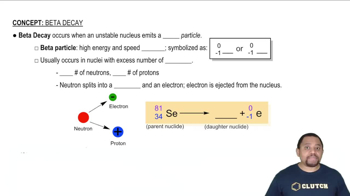Here are the essential concepts you must grasp in order to answer the question correctly.
Radioactive Decay
Radioactive decay is the process by which an unstable atomic nucleus loses energy by emitting radiation. This can occur through various pathways, including alpha decay, beta decay, and gamma decay. In the case of technetium-100 (100Tc), it transforms into a more stable isotope, molybdenum-100 (100Mo), through specific decay processes.
Recommended video:
Rate of Radioactive Decay
Balanced Nuclear Equations
A balanced nuclear equation represents the transformation of one element into another during radioactive decay, ensuring that the total number of protons and neutrons is conserved. Each side of the equation must have the same mass number and atomic number. This is crucial for accurately depicting the decay pathways of isotopes like 100Tc to 100Mo.
Recommended video:
Balancing Chemical Equations
Decay Pathways
Decay pathways refer to the different routes through which a radioactive isotope can decay into a stable or less stable isotope. For 100Tc, the two common pathways include beta decay, where a neutron is converted into a proton, and positron emission, where a proton is converted into a neutron. Each pathway results in the formation of 100Mo but involves different particles and energy changes.
Recommended video:
 Verified step by step guidance
Verified step by step guidance

